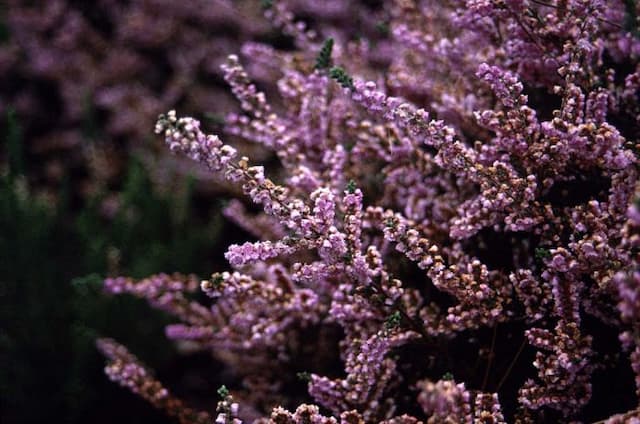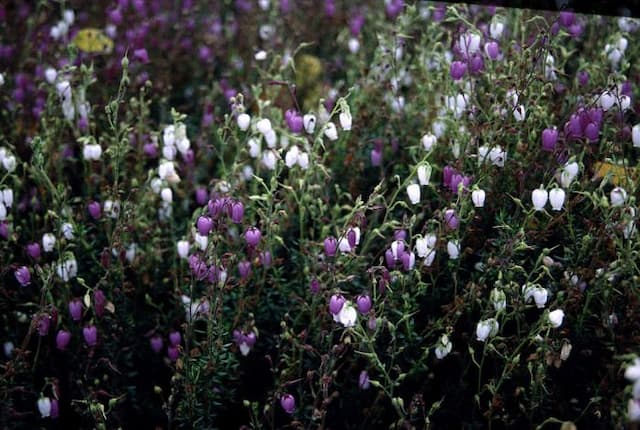Tree Heath Erica arborea var. alpina f. aureifolia 'Albert's Gold'











ABOUT
The plant known as 'Albert's Gold' is a visually striking variety characterized primarily by its golden-yellow foliage. The needle-like leaves provide a bright splash of color which stands out vividly against the greener backdrop of a garden or natural setting. These leaves are typically dense, creating a sort of fluffy or bushy appearance that gives the plant a soft texture from a distance. During blooming season, this plant produces small bell-shaped flowers which may add an additional layer of aesthetic interest. The flowers usually emerge in clusters, creating little pops of color that contrast nicely with the golden foliage. Overall, 'Albert's Gold' is known for its colorful allure and can serve as an eye-catching specimen in various landscape designs due to its distinctive coloring.
About this plant
 Names
NamesFamily
Ericaceae
Synonyms
Albert's Gold Tree Heather, Golden Tree Heather, Albert's Gold Broom Heather
Common names
Erica arborea var. alpina f. aureifolia 'Albert's Gold'.
 Toxicity
ToxicityTo humans
Tree Heath, in general, is not commonly listed as a toxic plant to humans. There is limited information suggesting any significant toxicity of Erica arborea to people. As with many plants, it's advisable to avoid ingesting parts of the plant, as they are not intended for human consumption and could potentially cause a mild stomach upset or an allergic reaction in sensitive individuals.
To pets
Tree Heath is also not widely recognized as a toxic plant to pets. While there is no substantial evidence that Erica arborea poses a significant risk of toxicity to animals, it's always prudent to prevent pets from consuming plant material. Ingestion could potentially lead to gastrointestinal discomfort, such as vomiting or diarrhea, particularly if the pet is not accustomed to eating such vegetation or has a tendency to be sensitive to new foods or plants.
 Characteristics
CharacteristicsLife cycle
Perennials
Foliage type
Evergreen
Color of leaves
Gold
Flower color
White
Height
4 feet (1.22 meters)
Spread
2 feet (0.61 meters)
Plant type
Shrub
Hardiness zones
7
Native area
Mediterranean
Benefits
 General Benefits
General Benefits- Aesthetic Appeal: 'Albert's Gold' provides year-round visual interest with its bright golden-yellow foliage.
- Landscape Versatility: This plant can be used in various landscape designs such as rock gardens, borders, and as a ground cover.
- Low Maintenance: It requires minimal care once established, making it suitable for gardeners of all skill levels.
- Drought Tolerance: Once established, it is capable of withstanding periods of low water availability.
- Cold Resistance: It is well-suited for cooler climates and can endure frost without significant damage.
- Wildlife Support: It offers shelter and nesting sites for birds, and its flowers provide nectar for bees and other pollinators.
- Erosion Control: Its root system helps stabilize slopes and prevent soil erosion.
 Medical Properties
Medical PropertiesThis plant is not used for medical purposes.
 Air-purifying Qualities
Air-purifying QualitiesThis plant is not specifically known for air purifying qualities.
 Other Uses
Other Uses- Instrument Craftsmanship: The wood of 'Albert's Gold' is used in manufacturing the bowls of briar pipes, a popular use due to its hard, heat-resistant properties.
- Engraving: Fine detail work, such as engraving, can be done on the wood given its fine grain and consistent texture.
- Specialty Paper Making: Fibers from 'Albert's Gold' can be used to create specialty paper with a unique texture and color.
- Model Making: Hobbyists might use the fine wood from this plant to create detailed models or miniatures, where precision and steadiness of the material are valued.
- Jewelry Making: Small pieces of the wood may be carved and polished to make beads or other elements for handmade jewelry.
- Horticultural Training: 'Albert's Gold' can be used as a subject in bonsai or topiary arts, providing a vibrant golden foliage for enthusiasts.
- Art Installation: The striking gold-colored foliage can be integrated into art installations or used for temporary sculptural works.
- Fragrance Distillation: The plant's aromatic qualities may be extracted to create fragrances, especially for home products.
- Photography Prop: ‘Albert’s Gold’s unusual golden foliage might be used as a niche prop for photographers looking for a unique plant feature.
- Educational Resource: The plant can serve as a botanical specimen in educational settings for teaching horticulture or plant biology.
Interesting Facts
 Feng Shui
Feng ShuiThe plant Tree Heather is not used in Feng Shui practice.
 Zodiac Sign Compitability
Zodiac Sign CompitabilityThe plant Tree Heather is not used in astrology practice.
 Plant Symbolism
Plant Symbolism- Protection: In some cultures, Erica (Heather) is associated with protection, attributed to its hardy nature that enables it to thrive in challenging environments.
- Good Luck: Heather has been considered a symbol of good luck, especially in Scottish tradition, where it's believed to bring good fortune when carried.
- Solitude: Due to its preference for growing in quiet, undisturbed areas, heather can symbolize a desire for solitude or peacefulness.
- Beauty: The attractive appearance of heather blooms is associated with beauty and admiration, reflecting its aesthetic appeal.
- New Beginnings: As heather often grows in barren landscapes and signals the renewal of life, it can represent new beginnings or resilience.
 Water
WaterFor the Tree Heath 'Albert's Gold', you should keep the soil consistently moist but not waterlogged. It's best to water deeply whenever the top inch of soil feels dry to the touch. Depending on the climate and weather conditions, this might mean watering every 7 to 10 days. In terms of the amount, this could be roughly 1 gallon per watering for a medium-sized plant, ensuring the water reaches the roots without causing standing water which can lead to root rot.
 Light
Light'Albert's Gold' prefers a position where it receives full to partial sunlight throughout the day. This ensures the best growth and foliage color. It can tolerate some light shade, but too much shadow may result in fewer blooms and less vigorous growth.
 Temperature
TemperatureThe ideal growing temperatures for Tree Heath 'Albert's Gold' range between 45 and 65 degrees Fahrenheit. It can survive in temperatures as low as 25 degrees Fahrenheit and should be protected if the temperature dips further to prevent frost damage. This plant thrives in cool to temperate climates.
 Pruning
PruningPrune Tree Heath 'Albert's Gold' to maintain shape and encourage bushy growth, typically once a year in late winter or early spring before new growth begins. It's also key to remove any dead or damaged wood to maintain plant health. Pruning after flowering helps promote new flower buds for the following season.
 Cleaning
CleaningAs needed
 Soil
Soil'Albert's Gold' Tree Heath thrives in well-draining, acidic soil with a pH of 4.5 to 5.5. A mix containing equal parts of peat moss, sandy loam, and pine bark is ideal to ensure good drainage and aeration. Regular check of soil pH is recommended to maintain the acidic conditions.
 Repotting
Repotting'Albert's Gold' Tree Heath should be repotted every two to three years. Best done in early spring before new growth starts, using a well-draining acidic soil mix to accommodate the root growth without causing stress to the plant.
 Humidity & Misting
Humidity & Misting'Albert's Gold' Tree Heath prefers moderate humidity levels, generally around 50-60%. It doesn't require high humidity and can tolerate drier air, but should not be placed in excessively dry environments.
 Suitable locations
Suitable locationsIndoor
Place in bright indirect light and well-draining soil.
Outdoor
Plant in partial shade; shelter from harsh sun.
Hardiness zone
7-9 USDA
 Life cycle
Life cycleErica arborea var. alpina f. aureifolia 'Albert's Gold', commonly known as 'Albert's Gold' Tree Heath, begins its life cycle as dormant seed, which requires stratification to break dormancy and germinate, usually in spring. Upon germination, the seedling grows and develops a root system and foliage, becoming a juvenile plant. As it matures, the plant undergoes vegetative growth, establishing a woody stem and branching structure with needle-like leaves that display its characteristic golden yellow color. After a few years, when it reaches maturity, 'Albert's Gold' Tree Heath blooms in the spring, producing clusters of white flowers that are attractive to bees and other pollinators. These flowers are subsequently pollinated and develop into fruit capsules containing seeds, which disperse to give rise to new plants. The plant cycle continues repeating the flowering and seeding process annually while it grows in size and can live for many years if environmental conditions are favorable.
 Propogation
PropogationPropogation time
Spring
The most popular method of propagation for this variety of tree heather, specifically Erica arborea var. alpina f. aureifolia 'Albert's Gold', is through semi-hardwood cuttings. This typically occurs during the late summer and early fall when the current year's growth has started to mature but isn't fully hardened. To propagate using this method, a gardener would take a cutting of about 4 to 6 inches (10 to 15 centimeters) in length, making sure there are several nodes present. Leaves on the lower half of the cutting should be removed, and the base dipped in rooting hormone to encourage root development. The cutting is then planted in a mix of peat and perlite or a similar rooting medium, kept moist, and placed in a warm environment with indirect light. A plastic cover can help maintain humidity levels around the cutting, creating an ideal condition for roots to form, which could take a few weeks to a couple of months.









